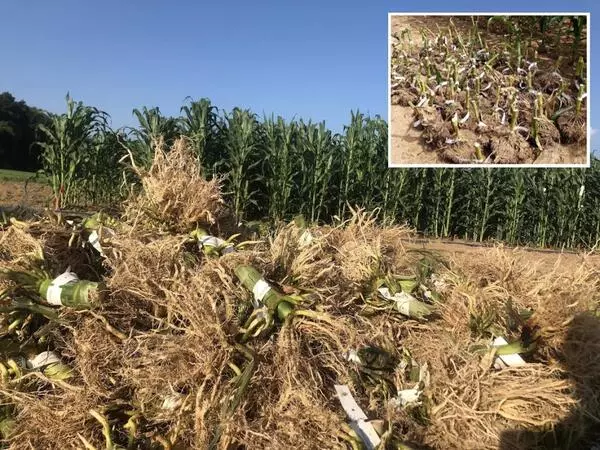The discovery of a root anatomy gene has the potential to significantly enhance the resilience of corn crops. The gene, known as ZmCIPK15, is responsible for regulating the growth of corn roots and determining their structure. This discovery could lead to the development of new corn varieties that are better able to withstand drought, heat, and other environmental stresses.
According to a Penn State-led team of international researchers, a new discovery reported in a global study spanning more than a decade of research could lead to the breeding of corn crops that can withstand drought and low-nitrogen soil conditions, ultimately alleviating global food insecurity.
The researchers identified a gene encoding a transcription factor (a protein useful for converting DNA into RNA) that activates a genetic sequence responsible for the development of an important trait that allows corn roots to acquire more water and nutrients, according to findings published in the Proceedings of the National Academy of Science.
According to research team leader Jonathan Lynch, distinguished professor of plant science, that observable trait, or phenotype, is called root cortical aerenchyma and results in the formation of air passages in the roots. His Penn State colleagues discovered that this phenotype makes roots metabolically cheaper, allowing them to better explore the soil and capture more water and nutrients from dry, infertile soil.
The results are significant because finding a gene behind an important trait that will help plants have better drought tolerance and better nitrogen and phosphorus capture looms large in the face of climate change.
Jonathan Lynch
Identifying the genetic mechanism underlying the trait now creates a breeding target, according to Lynch, whose research group in the College of Agricultural Sciences has been studying root traits in corn and beans for more than three decades in the United States, Asia, Latin America, Europe, and Africa with the goal of improving crop performance.
Hannah Schneider, a former doctoral student and postdoctoral scholar in the Lynch lab, is now an assistant professor of crop physiology at Wageningen University & Research in the Netherlands. In the study, she used powerful genetic tools developed in previous Penn State research to perform “high-throughput phenotyping” on thousands of roots in a short period of time.
She discovered the gene — a “bHLH121 transcription factor” — that causes corn to express root cortical aerenchyma using technologies such as Laser Ablation Tomography and the Anatomics Pipeline, as well as genome-wide association studies. However, Schneider noted that locating and then validating the genetic underpinnings of the root trait took time.

“We began the field experiments that led to this study in 2010, growing over 500 lines of corn at sites in Pennsylvania, Arizona, Wisconsin, and South Africa,” she explained. “I worked at all of those places. We saw compelling evidence that we had discovered a gene linked to root cortical aerenchyma.”
But, according to Schneider, proving the concept took a long time. To demonstrate the causal relationship between the transcription factor and the formation of root cortical aerenchyma, the researchers created multiple mutant corn lines using genetic manipulation methods such as the CRISPR/Cas9 gene-editing system and gene knockouts.
“It took years not only to create those lines, but also to phenotype them in different conditions to validate the function of this gene,” she said. “We spent 10 years on this, confirming and validating our results, to make sure that this is the gene and the specific transcription factor that controls root cortical aerenchyma formation. Doing this type of work in the field and digging up and phenotyping roots of mature plants was a long process.”
In the paper, the researchers reported that functional studies revealed that the mutant corn line with the bHLH121 gene knocked out and a CRISPR/Cas9 mutant line in which the gene was edited to suppress its function both showed reduced root cortical aerenchyma formation. In contrast, an overexpression line exhibited significantly greater root cortical aerenchyma formation when compared to the wildtype corn line.
According to the researchers, characterization of these lines under suboptimal water and nitrogen availability in multiple soil environments revealed that the bHLH121 gene is required for root cortical aerenchyma formation. Furthermore, they propose that the overall validation of the bHLH121 gene’s role in root cortical aerenchyma formation provides a new marker for plant breeders to select varieties with improved soil exploration, and thus yield, under suboptimal conditions.
This research represents the culmination of 30 years of work at Penn State for Lynch, who plans to retire from the Department of Plant Sciences faculty at the end of this year.
“These findings are the result of many people at Penn State and beyond collaborating with us over many years,” he said. “We discovered the function of the aerenchyma trait and then the gene associated with it. It was made possible by technologies developed at Penn State, such as Shovelomics (digging up roots in the field), Laser Ablation Tomography, and Anatomics Pipeline. In this work, we combined all of those elements.”
Lynch continued, “The results are significant because finding a gene behind an important trait that will help plants have better drought tolerance and better nitrogen and phosphorus capture looms large in the face of climate change.”





